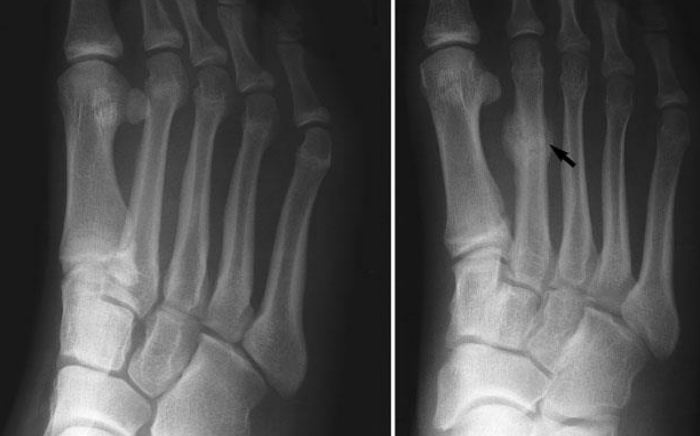What is Metatarsal Stress Fractures?
STRESS FRACTURES
When excessive stress is placed upon the ball of the foot, a hairline break (fracture) of a long metatarsal bone may occur. This occurs most frequently to the second, third, or fourth metatarsal but can occur in any bone. Frequently, the injury is so subtle that you may not recall any specific occurrence. These fractures were at one time referred to as “March Fractures” in soldiers, who developed foot pain after long periods of marching. Stress fractures can occur during sports activities, in overweight individuals, or in those with weakened bones such as osteoporosis.

What Causes Metatarsal Stress Fractures?
Stress fractures often result from increasing the amount or intensity of an activity too quickly.
Bone adapts gradually to increased loads through remodeling, a normal process that speeds up when the load on the bone increases. During remodeling, bone tissue is destroyed (resorption), then rebuilt.
Bones subjected to unaccustomed force without enough time for recovery resorb cells faster than your body can replace them, which makes you more susceptible to stress fractures.
Factors that can increase your risk of stress fractures include:
- Certain sports. Stress fractures are more common in people who engage in high-impact sports, such as track and field, basketball, tennis, dance or gymnastics.
- Increased activity. Stress fractures often occur in people who suddenly shift from a sedentary lifestyle to an active training regimen or who rapidly increase the intensity, duration or frequency of training sessions.
- Sex. Women, especially those who have abnormal or absent menstrual periods, are at higher risk of developing stress fractures.
- Foot problems. People who have flat feet or high, rigid arches are more likely to develop stress fractures. Worn footwear contributes to the problem.
- Weakened bones. Conditions such as osteoporosis can weaken your bones and make it easier for stress fractures to occur.
- Previous stress fractures. Having had one or more stress fractures puts you at a higher risk of having more.
- Lack of nutrients. Eating disorders and lack of vitamin D and calcium can make bones more likely to develop stress fractures.
Metatarsal Stress Fractures Diagnosis
A typical presentation for someone with a metatarsal stress fracture would be pain and swelling in the ball of the foot, which is most severe in the push-off phase of walking. Pressing on the bones in this area of the foot will reproduce the pain. X-rays are taken during the first two to three weeks after the injury often will not show any fracture. A bone scan at this stage will be much more sensitive in diagnosing the early stress fracture. The decision to order a bone scan will be up to your doctor. Often times the diagnosis can be made based upon clinical findings, thus making the bone scan unnecessary. After several weeks, an x-ray will show the signs of new bone healing in the area of the stress fracture.
Metatarsal Stress Fracture Treatment
Treatment for a metatarsal stress fracture usually consists of rest, elevation, and ice initially. Sometimes a compression bandage is applied to help reduce the swelling. Frequently a post-operative type of shoe or removable below the knee cast is used to prevent you from pushing off the ball of your foot, thus eliminating any additional stress while the bone is healing. Occasionally a short leg walking cast may be applied for a short period of time. Typical healing times range from 4 to 8 weeks. After the fracture is healed, special attention should be paid to using a well-padded insole or a functional orthotic in the shoes to reduce the stress in this area. For those who may have osteoporosis, bone densitometry testing should be done, and appropriate treatment initiated to prevent further weakening of the bones.
Our Board Certified Podiatrists
Socal Foot and Ankle doctors are committed to delivering the most exceptional treatments.

Board Certified Foot & Ankle Specialist
Office Time
Location: Santa Monica
Mon – Thur: 9:00 AM – 5:00 PM
Friday: 9:00 AM – 5:00 PM
Location Marina Del Rey
Mon – Thur: 9:00 AM – 5:00 PM
Friday: 9:00 AM – 5:00 PM
Location: Cedars Sinai
Mon – Thur: 9:00 AM – 5:00 PM
Friday: 9:00 AM – 5:00 PM

Board Certified Foot & Ankle Specialist
Office Time
Location: Santa Monica
Mon – Thur: 9:00 AM – 5:00 PM
Friday: 9:00 AM – 5:00 PM

BOARD CERTIFIED
FOOT & ANKLE
Surgeons
- Comprehensive Treatment of Foot & Ankle Conditions in the Pediatric, Adult & Geriatric population
- 3 Practice Locations Santa Monica Medical Plaza, Cedars Sinai Medical Towers, & UCLA Health in Marina Del Rey
- On Staff with Providence Saint Johns Health Center &Cedars Sinai Medical Center
